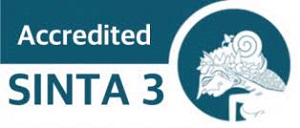ADDITIONAL MENU
Lithology Prediction Using Deep Learning Artificial Neural Network and Schlumberger Resistivity Inversion Data at Eastern Lampung
Abstract
The Schlumberger geoelectric method has been extensively employed in earth resource exploration due to its capability to identify variations in subsurface resistivity. However, the manual interpretation of geoelectric data inversion results is often subjective and time-consuming. This study aims to automate the lithology identification process by utilizing deep learning techniques, particularly Artificial Neural Networks (ANN), based on the inverted resistivity parameters obtained through the IPI2Win software. The Schlumberger configuration geoelectric data were obtained from survey reports provided by the Ministry of Public Works and Housing (Kementerian Pekerjaan Umum dan Perumahan Rakyat/ PUPR), which conducted geoelectric measurements in East Lampung Regency, Lampung Province, Indonesia. The ANN algorithm demonstrated an average accuracy of 90% in predicting lithology based on resistivity patterns resulting from Schlumberger inversion. Outperforming Support Vectorr Machine (SVM) (87%) and XGBoost (88%). These results confirm the initial hypothesis that ANN can effectively capture the complex relationships between resistivity values and rock types. The present study proposes an integrated approach between geophysics and machine learning with ANN algorithms for lithology prediction based on Schlumberger configuration geophysical inversion data. The present study proposes an integrated approach between geophysics and machine learning with ANN algorithms for lithology prediction based on Schlumberger configuration geophysical inversion data.
Keywords
Artificial Neural Network; Deep Learning; Lithology Prediction; Schlumberger Geoelectric
Full Text:
PDFReferences
G. Chen, M. Chen, G. Hong, Y. Lu, B. Zhou, and Y. Gao, “A new method of lithology classification based on convolutional neural network algorithm by utilizing drilling string vibration data,” Energies (Basel), vol. 13, no. 4, 2020, doi: 10.3390/en13040888.
M. Yang, Y. Hu, B. Liu, L. Wang, Z. Zhou, and M. Jia, “Application of Artificial Neural Networks for Identification of Lithofacies by Processing of Core Drilling Data,” Applied Sciences (Switzerland), vol. 13, no. 21, Nov. 2023, doi: 10.3390/app132111934.
S. H. R. Mousavi and S. M. Hosseini-Nasab, “Residual Convolutional Neural Network for Lithology Classification: A Case Study of an Iranian Gas Field,” Int J Energy Res, vol. 2024, 2024, doi: 10.1155/2024/5576859.
H. Liang, H. Chen, J. Guo, J. Bai, and Y. Jiang, “Research on lithology identification method based on mechanical specific energy principle and machine learning theory,” Expert Syst Appl, vol. 189, Mar. 2022, doi: 10.1016/j.eswa.2021.116142.
M. A. M. Abdullah, A. A. Mohammed, and S. R. Awad, “RockDNet: Deep Learning Approach for Lithology Classification,” Applied Sciences (Switzerland), vol. 14, no. 13, Jul. 2024, doi: 10.3390/app14135511.
D. Fu, C. Su, W. Wang, and R. Yuan, “Deep learning based lithology classification of drill core images,” PLoS One, vol. 17, no. 7 July, Jul. 2022, doi: 10.1371/journal.pone.0270826.
R. S. Permana, A. P. Buana, A. Akmam, H. Amir, and A. Putra, “Using the Schlumberger configuration resistivity geoelectric method to estimate the rock structure at landslide zone in Malalak agam,” in Journal of Physics: Conference Series, Institute of Physics Publishing, May 2020. doi: 10.1088/1742-6596/1481/1/012034.
A. A. Sembiring and A. Akmam, “Damping Factors in the Interpretation of Geoelectric Data (Case Study: Malalak Agam Rock Structure),” ALSYSTECH Journal of Education Technology, vol. 2, no. 2, pp. 141–159, May 2024, doi: 10.58578/alsystech.v2i2.3082.
K. D. Oyeyemi et al., “Geoengineering site characterization for foundation integrity assessment,” Cogent Eng, vol. 7, no. 1, Jan. 2020, doi: 10.1080/23311916.2020.1711684.
H. Singh, Y. Seol, and E. M. Myshakin, “Automated Well-Log Processing and Lithology Classification by Identifying Optimal Features through Unsupervised and Supervised Machine-Learning Algorithms,” SPE Journal, vol. 25, no. 5, pp. 2778–2800, Oct. 2020, doi: 10.2118/202477-PA.
A. Singh, M. Ojha, and K. Sain, “Predicting lithology using neural networks from downhole data of a gas hydrate reservoir in the Krishna-Godavari basin, eastern Indian offshore,” Geophys J Int, vol. 220, no. 3, pp. 1813–1837, Mar. 2020, doi: 10.1093/gji/ggz522.
J. J. Marquina-Araujo et al., “Application of Multilayer Perceptron Neural Network in Geological Modeling of Categorical Variables: A Case Study in Peru,” Mathematical Modelling of Engineering Problems, vol. 11, no. 6, pp. 1463–1472, Jun. 2024, doi: 10.18280/mmep.110607.
F. Gurcan and A. Soylu, “Learning from Imbalanced Data: Integration of Advanced Resampling Techniques and Machine Learning Models for Enhanced Cancer Diagnosis and Prognosis,” Cancers (Basel), vol. 16, no. 19, Oct. 2024, doi: 10.3390/cancers16193417.
N. Nnamoko and I. Korkontzelos, “Efficient treatment of outliers and class imbalance for diabetes prediction,” Artif Intell Med, vol. 104, Apr. 2020, doi: 10.1016/j.artmed.2020.101815.
M. Koziarski, “Potential Anchoring for imbalanced data classification,” Pattern Recognit, vol. 120, Dec. 2021, doi: 10.1016/j.patcog.2021.108114.
W. M. (William M. Telford 1917-1997, Applied geophysics. Second edition. Cambridge [England] ; New York : Cambridge University Press, 1990., 1990. [Online]. Available: https://search.library.wisc.edu/catalog/999608560002121
J. M. Reynolds, An introduction to applied and environmental geophysics. Chichester ; New York : John Wiley, 1997., 1997. [Online]. Available: https://search.library.wisc.edu/catalog/999809641902121
M. A. Mohammed, N. M. Muztaza, and R. Saad, “The influence of non-collinear electrodes arrangement on a two-dimensional resistivity survey using wenner array,” in Journal of Physics: Conference Series, IOP Publishing Ltd, Mar. 2021. doi: 10.1088/1742-6596/1825/1/012012.
Y. Palimbong, M. Arisalwadi, E. Agustriani, J. D. Anggraeni, and Kusnadi, “Interpretation of surface structure on artisanal and small scale gold mining areas with geoelectric resistivity method of schlumberger configuration in Sekotong, West Lombok,” in IOP Conference Series: Earth and Environmental Science, Institute of Physics Publishing, Jan. 2020. doi: 10.1088/1755-1315/413/1/012007.
T. Dahlin and B. Zhou, “A numerical comparison of 2D resistivity imaging with 10 electrode arrays,” 2004.
O. R. Hermawan and D. P. Eka Putra, “The Effectiveness of Wenner-Schlumberger and Dipole-dipole Array of 2D Geoelectrical Survey to Detect The Occurring of Groundwater in the Gunung Kidul Karst Aquifer System, Yogyakarta, Indonesia,” Journal of Applied Geology, vol. 1, no. 2, p. 71, Jul. 2016, doi: 10.22146/jag.26963.
B. Mirzaei, B. Nikpour, and H. Nezamabadi-pour, “CDBH: A clustering and density-based hybrid approach for imbalanced data classification,” Expert Syst Appl, vol. 164, Feb. 2021, doi: 10.1016/j.eswa.2020.114035.
K. Kalaivanan, B. Gurugnanam, M. Suresh, Karung Phaisonreng Kom, and S. Kumaravel, “Geoelectrical resistivity investigation for hydrogeology conditions and groundwater potential zone mapping of Kodavanar sub-basin, southern India,” Sustain Water Resour Manag, vol. 5, no. 3, pp. 1281–1301, Sep. 2019, doi: 10.1007/s40899-019-00305-6.
J. S. Ejepu, M. O. Jimoh, S. Abdullahi, I. A. Abdulfatai, S. T. Musa, and N. J. George, “Geoelectric analysis for groundwater potential assessment and aquifer protection in a part of Shango, North-Central Nigeria,” Discover Water, vol. 4, no. 1, Jun. 2024, doi: 10.1007/s43832-024-00091-z.
G. S. Lumacad and R. A. Namoco, “Multilayer Perceptron Neural Network Approach to Classifying Learning Modalities Under the New Normal,” Aug. 2022. doi: 10.36227/techrxiv.20428230.v1.
J. Zhang, T. Wang, Z. Zhang, P. Yan, and X. Li, “QiMLP: Quantum-inspired Multilayer Perceptron with Strong Correlation Mining and Parameter Compression,” 2025. [Online]. Available: www.aaai.org
A. Fierravanti, L. Balducci, and T. Fonseca, “Cork Oak Regeneration Prediction Through Multilayer Perceptron Architectures,” Forests, vol. 16, no. 4, Apr. 2025, doi: 10.3390/f16040645.
A. Tashakkori, M. Talebzadeh, F. Salboukh, L. Deshmukh, and H. Talebzadeh, “Forecasting Gold Prices with MLP Neural Networks: A Machine Learning Approach,” International Journal of Science and Engineering Applications, Jul. 2024, doi: 10.7753/ijsea1308.1003.
K. A. Rashedi, M. T. Ismail, S. Al Wadi, A. Serroukh, T. S. Alshammari, and J. J. Jaber, “Multi-Layer Perceptron-Based Classification with Application to Outlier Detection in Saudi Arabia Stock Returns,” Journal of Risk and Financial Management, vol. 17, no. 2, Feb. 2024, doi: 10.3390/jrfm17020069.
O. W. Layton, S. Peng, and S. T. Steinmetz, “ReLU, Sparseness, and the Encoding of Optic Flow in Neural Networks,” Sensors, vol. 24, no. 23, Dec. 2024, doi: 10.3390/s24237453.
R. K. Vasanthakumari, R. V. Nair, and V. G. Krishnappa, “Improved learning by using a modified activation function of a Convolutional Neural Network in multi-spectral image classification,” Machine Learning with Applications, vol. 14, p. 100502, Dec. 2023, doi: 10.1016/j.mlwa.2023.100502.
L. Alzubaidi et al., “Review of deep learning: concepts, CNN architectures, challenges, applications, future directions,” J Big Data, vol. 8, no. 1, Dec. 2021, doi: 10.1186/s40537-021-00444-8.
N. Susanto and H. F. Pardede, “Feature Learning using Deep Variational Autoencoder for Prediction of Defects in Car Engine,” in Proceeding - 2024 International Conference on Information Technology Research and Innovation, ICITRI 2024, Institute of Electrical and Electronics Engineers Inc., 2024, pp. 311–316. doi: 10.1109/ICITRI62858.2024.10699115.
A. White et al., “Assessing the effect of offline topography on electrical resistivity measurements: insights from flood embankments,” Geophys J Int, Sep. 2024, doi: 10.1093/gji/ggae313.
J. Ważny, M. Stefaniuk, and A. Cygal, “Estimation of electrical resistivity using artificial neural networks: a case study from Lublin Basin, SE Poland,” Acta Geophysica, vol. 69, no. 2, pp. 631–642, Apr. 2021, doi: 10.1007/s11600-021-00554-0.
Y. Bai et al., “Understanding and Improving Early Stopping for Learning with Noisy Labels Supplementary A Training details,” 2021.
DOI: http://dx.doi.org/10.24014/ijaidm.v8i2.37652
Refbacks
- There are currently no refbacks.
Office and Secretariat:
Big Data Research Centre
Puzzle Research Data Technology (Predatech)
Laboratory Building 1st Floor of Faculty of Science and Technology
UIN Sultan Syarif Kasim Riau
Jl. HR. Soebrantas KM. 18.5 No. 155 Pekanbaru Riau – 28293
Website: http://predatech.uin-suska.ac.id/ijaidm
Email: ijaidm@uin-suska.ac.id
e-Journal: http://ejournal.uin-suska.ac.id/index.php/ijaidm
Phone: 085275359942
Journal Indexing:
Google Scholar | ROAD | PKP Index | BASE | ESJI | General Impact Factor | Garuda | Moraref | One Search | Cite Factor | Crossref | WorldCat | Neliti | SINTA | Dimensions | ICI Index Copernicus
IJAIDM Stats










